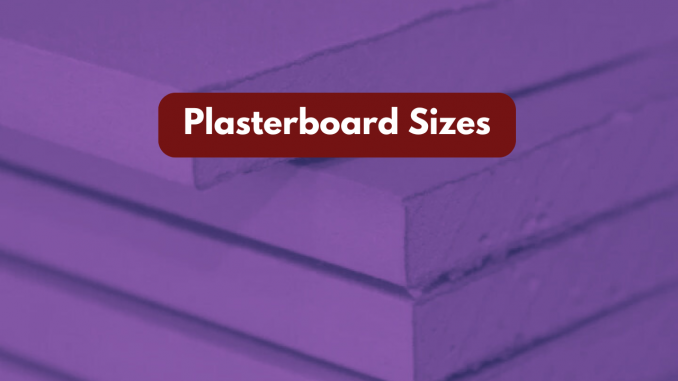

Plasterboard, also known as drywall or gypsum board, is an essential building material widely used in the construction of walls, ceilings, and partitions. Its popularity stems from its versatility, ease of installation, and ability to provide a smooth finish ready for painting or wallpapering. One of the critical considerations when working with plasterboard is selecting the correct size for your project. In the UK, plasterboard comes in various sizes and thicknesses, each suited to different applications. This guide will explore the standard plasterboard sizes available in the UK and their specific uses.
Standard Plasterboard Sizes
In the UK, plasterboard is typically available in several standard sizes, with the most common dimensions being:
- 2400mm x 1200mm (8ft x 4ft): This is the most widely used size in the UK. It covers 2.88 square meters per sheet and is suitable for most residential and commercial applications, including walls and ceilings. Its large size helps reduce the number of joints, leading to a smoother finish.
- 1800mm x 900mm (6ft x 3ft): A smaller size compared to the 2400mm x 1200mm board, this size is easier to handle and transport, making it ideal for smaller projects or areas where maneuverability is a concern.
- 1200mm x 900mm (4ft x 3ft): This size is often used for repairs or small-scale projects. Its compact dimensions allow it to be fitted in tight spaces, and it’s easier to work with in confined areas.
- 3000mm x 1200mm (10ft x 4ft): A larger board that covers 3.6 square meters per sheet, this size is used for large-scale projects where speed and efficiency are essential. It is often used in commercial settings where walls need to be covered quickly.
Plasterboard Thickness
Plasterboard also comes in various thicknesses, each serving a specific purpose:
- 9.5mm: This is the thinnest option and is generally used for ceilings where a lighter material is needed to prevent sagging. It’s also used for curved partitions due to its flexibility.
- 12.5mm: The most common thickness for walls, this board provides a good balance between strength and ease of handling. It’s suitable for most internal walls and can support a variety of finishes, including tiles and heavy wallpaper.
- 15mm: Thicker plasterboard offers enhanced sound insulation and fire resistance. It is commonly used in areas requiring these additional properties, such as between apartments in residential buildings or in commercial properties where noise reduction is critical.
- 19mm: This is a specialist thickness used in applications that require high levels of fire resistance, such as in specific fire-rated partitions.
Different types of Plasterboard
In addition to standard plasterboards, the UK market also offers several specialist boards tailored for specific functions:
Soundproof Plasterboard
Typically 12.5mm to 15mm thick, these boards are designed to reduce sound transmission between rooms. They are often used in bedrooms, home offices, and between shared walls in flats.
Moisture-Resistant Plasterboard
Available in standard sizes like 2400mm x 1200mm and typically 12.5mm thick, this type is used in areas prone to dampness, such as bathrooms, kitchens, and utility rooms. It has water-resistant additives in the core to prevent moisture absorption.
Fire-Resistant Plasterboard
These boards, available in 12.5mm and 15mm thicknesses, are designed to provide extra fire protection. They are often installed in commercial buildings, stairwells, and ceilings where fire resistance is a building code requirement.
Thermal Insulated Plasterboard
This type comes with an additional layer of insulation material on the back, providing both thermal insulation and plasterboard in one. It’s commonly used in external walls to improve a building’s energy efficiency.
Choosing the right size and type of plasterboard is crucial for the success of any construction or renovation project. In the UK, plasterboard is available in a range of sizes and thicknesses to meet different building requirements, from standard walls and ceilings to specialised applications like soundproofing, moisture resistance, and fire protection. By understanding the options available, builders and DIY enthusiasts can select the most suitable plasterboard to ensure a high-quality finish and long-lasting performance.
Which plasterboard thickness should I use for walls?
The 12.5mm thickness is the most commonly used for walls. It offers adequate strength, supports a variety of finishes, and is suitable for most residential and commercial applications.
What size plasterboard is best for ceilings?
The 2400mm x 1200mm (8ft x 4ft) size is commonly used for ceilings as it covers a large area and reduces the number of joints. For ceilings, a 9.5mm thickness is often preferred due to its lighter weight, which helps prevent sagging.
What is the largest size of plasterboard available in the UK?
The largest standard size commonly available in the UK is 3000mm x 1200mm (10ft x 4ft). This size is typically used in large commercial projects where covering large areas quickly is essential.
Is there a difference between plasterboard for walls and ceilings?
Yes, while standard plasterboard can be used for both walls and ceilings, 9.5mm thick boards are often recommended for ceilings due to their lighter weight. 12.5mm thick boards are generally used for walls due to their strength and durability.
What is moisture-resistant plasterboard?
Moisture-resistant plasterboard is treated with water-repellent additives, making it suitable for areas exposed to high humidity, such as bathrooms, kitchens, and utility rooms. It typically comes in standard sizes like 2400mm x 1200mm and is 12.5mm thick.
What is the best plasterboard for soundproofing?
For soundproofing, thicker plasterboards such as 15mm or specially designed soundproof plasterboards (which may also include additional sound-absorbing materials) are ideal. These boards help reduce noise transmission between rooms, making them suitable for bedrooms, home offices, and shared walls in flats.
